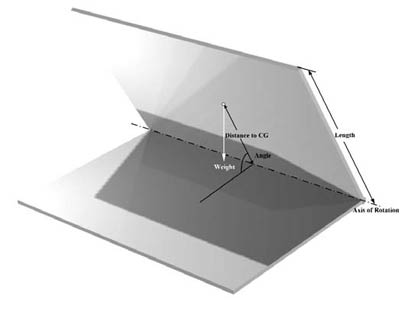The Leading Manufacturer of
Friction Hinges and Torque Hinges
Torque Hinge Calculator
The torque exerted by the display on the hinge at a particular angle is given by:Torque = Weight x Distance from the Axis of Rotation to Center of Gravity x Cos of the Angle.If the weight of the display is evenly distributed, the distance from the axis of rotation to the center of gravity is equal to half the length of the display. (Example shown below)

How To Specific a Torque Hinge
A typical use of a torque hinge is the attachment of a laptop computer screen to its base. Whlie this is a more common application, the selection process generally applies to similar uses as well. For laptops, the hinge(s) serve two functions.
- Hold the laptop together throughout its useful life, inclusive of the functional range of motion and inevitable bumps, bangs and bruises.
- Maintain a force resisting motion to allow proper positioning of the screen for comfortable viewing and use of the laptop.
When considering the torque hinge(s) required, several basic parameters must be defined to properly outline the characteristics and the physical constraints of the design. These are:
- What is the weight of the screen and the length of the lever arm from the axis of rotation to the center of gravity(Cg)?
- What is the weight and Cg distance for the base of the laptop in all conditions/configurations? Do feet on the unit impact this value?
- At what angles must the display be positioned (working range)?
- What ergonomic feel will your customer be satisfied with? (How hard or easy must it be to move the screen?)
- Is it allowable or preferable for the screen to gently fall closed from some angle?
- Would your customer prefer balanced or unbalanced torque? (Often unbalanced with opening torque 30% less than closing torque offers users a more natural feel in operation.)
- Is it acceptable for the user to use two hands to position the screen? (Hold the base in place as the screen is moved.)
- What type of vibrational loading will the laptop be subject to in use?
- What type of drop loading will the laptop be expected to survive?
- How much room do I have? (X,Y, Z constraints)
- What am I attaching the hinge to and how am I fastening it?
Note: Mounting constraints should play a large part in developing or considering the initial hinge design and specification as they impact the ability of the hinge to perform its two primary functions. This often can impact the user experience as much as proper designation of the hinge torque specification.
Additional parameters for the torque hinge may include:
- Appropriate level of resistance to corrosion.
- Cosmetic requirements.
- Life cycle requirements.
- Tolerancing specifications.
- Serviceability (disassembly) requirements for the Laptop.
- Integration into your assembly process.
- Suitable (appropriate) level of quality inspection.
Need help specifying the right torque hinge for your needs? Contact us today.
